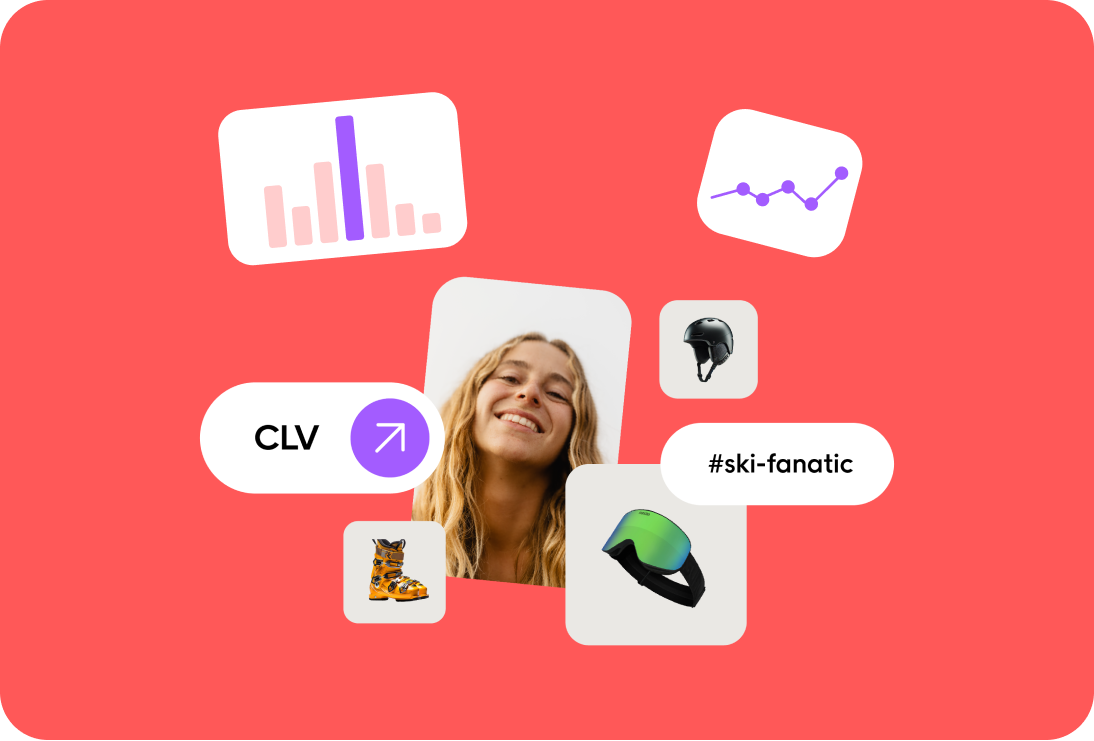TL;DR
- A single view of the customer turns disconnected data into one clear story your whole business can act on.
- Retailers who connect store and online data see real loyalty gains and measurable revenue lift, not just higher engagement.
- Unified customer data fuels every part of your marketing, from personalization to smarter use of AI.
- You can create a single customer view faster than you think when your data, loyalty, and activation tools work together.
- Voyado shows how connected data turns into connected experiences that grow your business.
Most retailers don’t really know their customers as well as they think they do.
Their data might know the name, but not the story behind it.
Voyado’s Retail Radar 2025 shows that more than half of shoppers say they’re loyalty members, yet many retailers can’t link those members’ in-store and online purchases.
That invisible gap hides the real value of your most engaged customers and limits how far your marketing can go.
When your teams can finally connect every purchase and interaction, you don’t just see data.
You see momentum.
You see where your customers are heading, what keeps them loyal, and how to meet them there. That clarity turns every decision into progress.
So, what does a single view of the customer really mean for your business, and why does it matter right now?
What a single view of the customer means for retail
Most teams think they already have a full picture of their customers.
But what they actually have is data spread across systems that don’t talk to each other.
A single view of the customer connects all that data into one complete profile so your business can finally see every part of the customer journey.
What is a single view of the customer
A single view of the customer (SCV) brings every piece of customer information together and includes things like:
- Purchase history
- Loyalty points
- Online behavior
- In-store interactions
Each profile combines identifiers like email, phone, and member ID with consent status and preferences.
It gives your marketing and CRM teams one accurate, unified source of truth instead of disconnected lists and reports.
Unlike a general customer relationship management system, which focuses on storing contact details, an SCV links every interaction and transaction across channels.
This makes it easier to personalize offers, measure customer value, and improve the overall customer experience.
Why a unified view matters now
Customer expectations have changed faster than most data systems.
Shoppers move between stores, apps, and websites without thinking about channels. They expect brands to recognize them instantly and reward them consistently.
That’s almost impossible when your customer data sits in silos. Clean, connected customer identities let your business use the same data everywhere, in:
- marketing automation platforms
- loyalty programs
- customer support interactions
This means fewer duplicates, faster decisions, and better customer service that feels seamless across every touchpoint.
The Retail Radar 2025 studies show that 73% of shoppers regularly look for discounts, and 51% are members of loyalty programs.
They’re not just buying products; they’re looking for recognition.
A single customer view helps you connect those moments into one continuous relationship instead of isolated transactions.
How it connects to your business goals
When your teams can rely on accurate customer profiles, everything from campaign planning to data management gets simpler. You can:
- Connect data across sales, marketing, and loyalty channels.
- Segment customers by behavior and lifetime value, not just email lists.
- Identify trends that drive revenue and brand loyalty.
- Build stronger customer relationships based on real insight.
Creating a single view of the customer is about helping every team understand the people behind the data so your business can deliver experiences that feel personal, consistent, and valuable.
So how do you actually build that connected foundation? Let’s look at what goes into creating a single customer view that your entire business can use with confidence.
How retailers build a single customer view that actually works
Once you understand what a single customer view means, the next step is to build it in a way that’s simple, accurate, and ready to use.
You don’t need a massive data team or months of setup. You just need to connect the right data sources and make sure they speak the same language.
Step 1: Connect your data sources
Start by linking the systems that hold your core customer data. That includes your e-commerce platform, POS, app, loyalty program, and email or SMS tools.
The goal is to store customer data from every interaction in one connected place.
Each profile should include:
- Identifiers: email, phone, member ID, or loyalty number
- Commerce data: product views, purchases, returns, and order value
- Engagement data: email clicks, SMS responses, push notifications, and store interactions
- Loyalty data: points, tiers, vouchers, and rewards activity
Your customer data platform becomes the engine that connects all these inputs. It turns raw data into complete customer profiles that marketing, loyalty, and analytics teams can use together.
Step 2: Resolve identities across channels
Most customers use different identifiers depending on where they shop. Someone might sign up for your newsletter with one email and buy in-store using a loyalty card. That’s why identity resolution is so important.
Start with the easy matches like email or phone number. Then use context, such as device and store location, to merge profiles safely and accurately.
Add clear consent tracking so your business always respects customer preferences and privacy.
Step 3: Keep your data clean and compliant
High-quality data is what makes the single customer view reliable. Make sure you:
- Standardize how events and IDs are named
- Remove duplicate data and define a single source of truth
- Limit what personal information you collect and how long you keep it
- Track consent history for every customer
Clean, organized data gives you confidence in every marketing and sales decision. It also helps your teams comply with privacy rules without slowing down campaigns.
Building your customer single view is about connecting the dots between the systems your teams already use.
When your data flows smoothly, your marketing gets faster, your insights get sharper, and your customer experience feels effortless.
Next, let’s look at how to create a single view of the customer in practice and what the build process actually looks like.
A practical roadmap to create a single view of the customer
Once your data is connected, the next step is making it useful. Building a single view of customer data can happen faster than you think.
With the right structure, your teams can turn disconnected data into a clear view that drives smarter decisions, stronger loyalty, and measurable growth.
Phase 1: Foundations – Connect and clean your data
Start by linking the systems that hold customer data across your business. Your e-commerce, POS, and CRM tools all store valuable but often siloed data about the same people.
Connecting them ensures everyone works with the same data instead of fragmented views.
What to focus on:
- Connect data sources such as e-commerce, POS, loyalty, and CRM systems.
- Store all the data in a single customer data platform.
- Combine identifiers (email, phone, loyalty ID) with consent, purchase history, and preferences.
- Remove duplicate data to improve data quality and accuracy.
This foundation lets every department access unified customer data that supports segmentation, customer retention, and brand loyalty.
Phase 2: Engagement – Track every interaction
Every email opened, push notification clicked, or in-store visit adds a valuable data point. These customer interactions help your team understand the entire customer journey, what drives engagement, and what converts.
How this helps:
- You can segment customers by interests and behaviors.
- Marketing automation platforms send more relevant marketing messages.
- Campaigns align with customer preferences, increasing satisfaction and conversion rates.
When your marketing and data management work together, your marketing efforts become more precise and your customer relationships stronger.
Phase 3: Loyalty – Add emotion to the data
Loyalty data brings context to your customer profiles. It shows not just what people buy but why they keep coming back.
Include in your single customer view (SCV):
- Loyalty points and reward tiers
- Voucher activity (earned, redeemed, expired)
- Purchase history tied to loyalty behavior
This unified view gives your team the insight to deliver better customer service and personalized loyalty experiences, both online and in-store.
Even store staff and customer support interactions benefit when they can instantly see a shopper’s status and preferences.
Need inspiration? Learn how to increase customer loyalty.
Phase 4: Activation – Put your customer data to work
Once your data is unified, it’s time to act on it. Use your SCV data to power real-time journeys and loyalty campaigns that enhance customer experience.
Quick wins:
- Welcome and onboarding journeys that match customer behavior
- Cart or browse abandonment reminders sent through the right channel
- Tier-based loyalty nudges that drive repeat sales
- Personalized recommendations powered by purchase history
Voyado makes this step simple by combining identity resolution, automation, and privacy controls in one system.
Your teams can connect data from multiple sources, launch campaigns quickly, and see clear results without switching between tools.
A structured roadmap helps your business connect data, people, and processes.
Each phase builds on the last, turning scattered information into something every team can use to deliver consistent, data-driven customer experiences.
Now comes the part your teams will love most: using your single customer view to create moments that drive loyalty, engagement, and growth.
High-impact ways to activate your single view of the customer
Once your single customer view is live, the real value comes from what you do with it.
A connected profile lets your teams move from guesswork to precision and turn every campaign into a relevant, timely experience.
Real results from Voyado customers
- By Malene Birger grew full-price shoppers by 109% with personalized onboarding powered by unified customer data.
- POWER A/S increased engagement by 300% through loyalty-driven automations built in Voyado.When every action comes from a single source of truth, performance follows.
1. Welcome and preference capture
First impressions count. Use your SCV to personalize onboarding from the start.
Try this:
- Ask new members about their favorite categories or preferred channels.
- Adapt your messaging and frequency to match those preferences.
A few smart questions at signup can shape the entire customer journey.
2. Abandonment anywhere
When a shopper leaves a cart or browses without buying, unified data makes follow-ups effortless.
Reach them where it counts:
Email, push, or SMS – wherever they’re most likely to respond. Keep timing respectful and always honor consent settings.
That’s how you turn reminders into service, not spam.
3. Tier acceleration
Use loyalty data to predict when members are close to the next tier. Then trigger offers that give them a nudge to complete their goal.
Why it works:
You reward progress, not just purchases, which strengthens loyalty and repeat spend.
4. Back-in-stock with store options
Blend online and offline data to create smarter inventory alerts. You could notify customers when an item returns and show where it’s available in the nearest store.
Add a small loyalty boost to increase conversion and reinforce brand loyalty.
In the Retail Radar 2025, in-store sales grew by nearly 12% across the Nordics while online sales dipped slightly.
A unified view of store and e-commerce data helps your teams meet customers wherever they shop.
5. Win-back by margin
Not every customer should receive the same offer.
Use behavioral and purchase history data to send incentives based on predicted margin and lifetime value.
This protects profitability while keeping your best customers engaged.
How Voyado makes activation easy
All of this happens inside one platform. Voyado combines marketing automation, loyalty, and personalization so your teams can:
- Launch omnichannel journeys fast.
- Avoid manual data pulls.
- Deliver connected, human experiences at scale.
Each of these use cases proves how a unified customer view helps your business build trust, improve customer relationships, and enhance customer experience at every step.
Now that activation is running smoothly, it’s time to prove the results.
How can you show that your single view of the customer is driving measurable business growth?
Proving value: Single customer view benefits and KPIs that matter
A single view of the customer isn’t just about smoother marketing. It’s about showing measurable business impact.
When your customer data is unified and accurate, you can finally prove the value of every campaign, channel, and loyalty initiative.
Why measurement matters:
Finance teams want numbers, not impressions. Your single customer view gives you the data quality and visibility to connect every marketing effort to revenue.
You can see which marketing campaigns drive repeat purchases, which channels deliver high-value customers, and how loyalty influences long-term retention.
1. Usable ID coverage
What it is: The percentage of orders linked to a known customer profile.
Why it matters: Higher coverage means your data collected is accurate and ready for activation. When you can identify more customers, you can deliver better customer service and smarter personalization.
2. Cross-channel repeat rate
What it is: The number of customers buying across two or more channels.
Why it matters: It shows how your customer experience performs beyond email or social. Unified customer data helps you understand where engagement truly happens, whether that’s in-store, online, or both.
3. Incremental revenue and margin mix
What it is: Cohort-based lift that compares those exposed to campaigns with a control group.
Why it matters: It reveals which customer interactions actually drive profit, not just traffic. This turns data management into a source of truth your finance team can trust.
4. Redemption health
What it is: The ratio of points earned to points redeemed.
Why it matters: Balanced redemption means your loyalty program is driving engagement, not liability. It’s a sign of customer satisfaction and long-term retention.
Proving the link between data and loyalty
When your teams use consistent, high-quality data across every channel, marketing and sales efforts become measurable.
You can quantify how your single customer view benefits both revenue and relationships.
To go deeper into financial impact, explore working with customer lifetime value. It explains how unified data reveals the real worth of every customer, not just their latest order.
The big takeaway:
A single customer view gives your business confidence in the numbers. It replaces assumptions with proof, and that’s what turns marketing from a cost center into a growth engine.
Your data now tells a clear story. But before your teams scale this further, you need to keep it compliant and secure. Let’s talk about how privacy fits into the picture.
When your single customer view goes live: What changes and what to avoid
Once your single customer view is up and running, your teams will feel the difference fast.
Campaigns run more smoothly, reports make more sense, and everyone finally works from the same version of the truth.
But like any major shift, it comes with a few surprises, both good and tricky.
What changes in your day-to-day work
| Before SCV | After SCV |
| Campaigns sent to static lists with limited context | Targeted segments built on behavior, value, and timing |
| Teams debate numbers from disconnected reports | Everyone works from unified data and shared results |
| Loyalty managed only by marketing | Store staff and service teams use loyalty data daily |
| Insights gathered at month-end | Performance tracked and optimized in real time |
Your single customer view makes daily work faster, clearer, and more coordinated across every team.
4 Ways teams often struggle
1. Collecting too much, too soon
It’s tempting to track every possible data point, but too much raw data can slow progress. Start with what drives real business value, like purchases, preferences, and engagement.
2. Ignoring data governance
As your database grows, so do your risks. Define who owns what, how you ensure data quality, and when to clean up inactive profiles. Without these rules, even the best system can become cluttered.
3. Discount-only loyalty
If every campaign depends on discounts, your margins will shrink. Mix in experiential or early-access rewards that show appreciation, not just price cuts.
4. Skipping staff training
Your single customer view only works if people use it. Store teams need to know how to identify customers and update preferences at checkout. Simple onboarding makes adoption stick.
The bottom line:
When your SCV data becomes part of daily work, the results compound. Marketing gets faster, reporting gets cleaner, and every customer interaction feels more personal.
But the real success comes from the habits you build around it, clear ownership, smart data use, and consistent training.
You’ve seen how SCV transforms daily operations. Let’s bring it all together to see where Voyado fits in and how it turns all this effort into measurable impact for your business.
Where Voyado fits: Turning your single customer view into measurable growth
Everything you’ve built so far, your connected data, unified profiles, and loyalty programs, becomes far more effective when it all runs in one place. That’s where Voyado fits in.
Voyado helps retailers connect, activate, and measure customer data without juggling multiple tools.
It brings together your customer data platform, marketing automation, and loyalty management so every team can use the same data with confidence.
Unified profiles that power every channel
Voyado combines customer identities, purchase history, and loyalty activity into one complete profile that’s ready to use across all your channels. This means:
- No more siloed data between e-commerce, app, and store systems
- One source of truth for customer interactions, consent, and preferences
- Faster campaign setup, fewer errors, and stronger data quality
Brands like Jack & Jones have seen measurable results from this approach.
By connecting online and offline data through Voyado, the team achieved a 33% higher average order value among members and built more consistent, personalized experiences across every channel.
A connected profile helps your teams make smarter decisions, strengthen customer relationships, and create experiences that feel seamless wherever people shop.
Activation that feels effortless
Once your single view of the customer is live, your teams can move from insights to action quickly. Voyado’s automation tools let you:
- Launch personalized campaigns across email, SMS, and in-store channels
- Use behavioral and loyalty data to tailor offers automatically
- Maintain data privacy and respect consent preferences in every message
If you want to see how this kind of personalization works in practice, explore personalization in retail.
Real measurement that proves ROI
Voyado connects your customer interactions and marketing efforts directly to measurable outcomes. Cohort reporting and holdout testing reveal how your campaigns drive:
- Incremental revenue and repeat purchases
- Healthier redemption ratios and loyalty engagement
- Higher lifetime value across your best customer segments
When your single customer view connects every data point, working with customer lifetime value stops being a guessing game. You can see exactly how loyalty drives growth across every channel.
You’ve seen how a single customer view connects data, strengthens loyalty, and proves real ROI.
Now it’s time to bring that clarity to your own business.
See how Voyado turns SCV into measurable lift across channels and stores when you book a demo.
FAQs
What is a single view of the customer?
It’s one complete profile that combines customer identities, purchase history, engagement, and consent across all channels.
How is SCV different from Customer 360?
Customer 360 is company-wide. A single customer view (SCV) focuses on marketing-ready data that drives personalization and loyalty.
Do I need a CDP to create an SCV?
Yes. A customer data platform connects all your data sources to build accurate, unified profiles.
Which metrics prove SCV value to finance?
Track incremental revenue, repeat purchases, and redemption health to show real financial impact.
How does loyalty data enhance an SCV?
It adds context to every profile, helping your teams personalize rewards, predict behavior, and build long-term retention.






